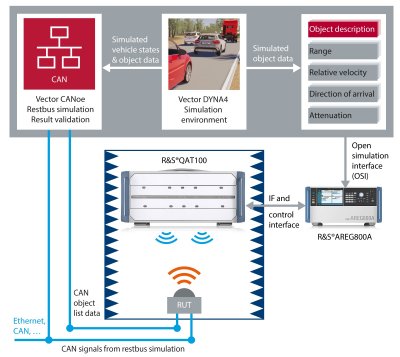Rohde & Schwarz and Vector Informatik Collaborate on Hardware-in-the-loop Validation of Automotive Radar Sensors
October 08, 2021
News

Rohde & Schwarz and Vector Informatik are collaborating on closed-loop scenario testing of automotive radar sensors for advanced driver assistance systems (ADAS) and autonomous driving (AD).
Coupling the DYNA4 virtual test drive simulation platform from Vector with the latest Rohde & Schwarz radar moving object stimulation system enables ideal verification of safety-critical ADAS functions. These include emergency braking in an integrated hardware-in-the-loop (HiL) environment.
The Vector DYNA4 virtual test drive software provides the environment simulation and the user interface for scenario configuration and test execution, and the Rohde & Schwarz radar test system generates dynamic artificial objects for the radar sensor under test based on ASAM OSI object lists implemented in the DYNA4 environment simulation software. Vector CANoe receives the radar sensor's bus output signals with the objects detected by the radar, and the software then analyzes and visualizes them. The detected objects are also compared with the simulated ground truth.

The Rohde & Schwarz radar test system comprises the R&S AREG800A automotive radar echo generator as the digital backend and the R&S QAT100 advanced antenna array as the frontend. The solution opens up possibilities for testing radar-enabled ADAS features and ensures the safety of autonomous driving functions in HiL setups.
Antenna array technology allows complex artificial objects to be generated for the radar sensors at variable distances and with variable radial velocity, object size, and angular direction. Antennas and test equipment do not need be moved physically. A responsive and dedicated HiL interface that conforms to the ASAM open simulation interface specification allows realistic over-the-air stimulation of radar sensors with challenging, complex, and even risky driving scenarios. The radar test system is future-proof thanks to a modular and scalable concept.
In addition to offering standard radar based ADAS feature tests such as adaptive cruise control (ACC) and autonomous emergency breaking (AEB) scenarios, the system can be upgraded to cover advanced test cases. It can grow to meet the complexity of future scenarios – an important step on the way to autonomous driving.
The combination of simulation and over-the-air radar stimulation is designed to accelerate the development of ADAS features and enable users to reliably and realistically test ADAS/AD features, and master complex validation processes in a fully controllable and representative environment.
For more information, visit: www.rohde-schwarz.com/us/about/news-press




